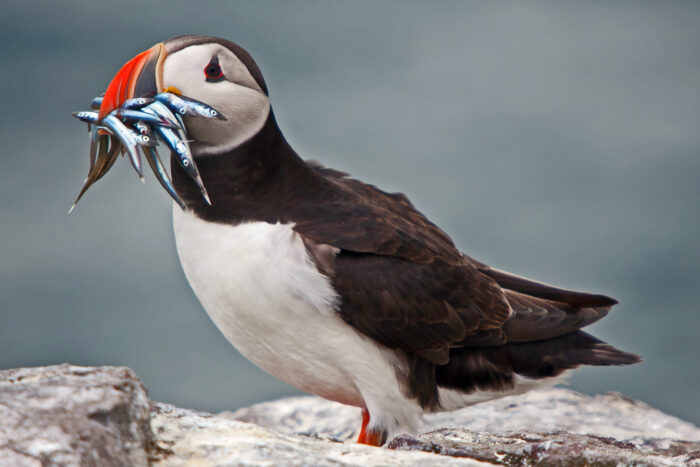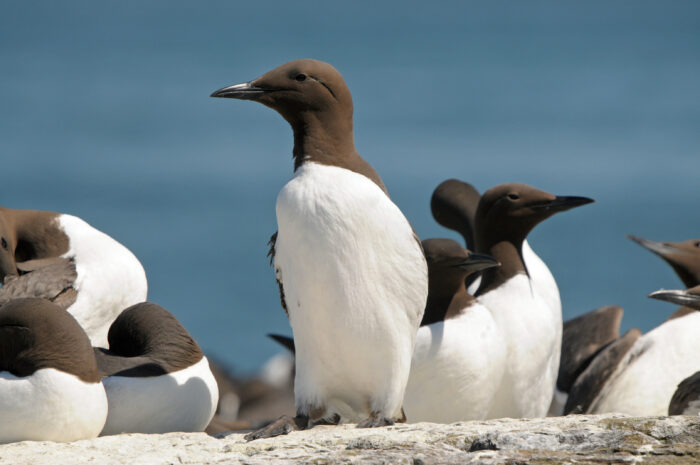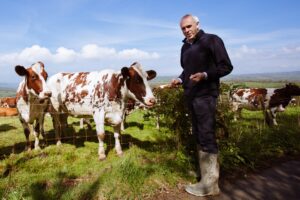
By Cristina Sellares, project officer for the ‘Birds on the Edge’ partnership
The Birds On The Edge partnership has submitted a planning application to create the first seabird reserve, free of invasive predators, in Europe, to protect locally endangered puffins, razorbills and other native wildlife. This application is the culmination of years of ecological research, engineering developments, and public consultation with Jersey’s community and businesses. This project stands to deliver biodiversity gains and to put Jersey in the European frontline of new technologies in conservation.
Seabirds are one of the most endangered groups of vertebrates globally with 56% of species in decline and 43% of species threatened with extinction. In recent years, UK seabird populations have shown alarming rates of decline and just last month (September 2024) five more species of seabird were added to the UK Red List of species requiring urgent conservation action.
Birds On The Edge has been concerned about the state of our Island’s seabird population for a long time, raising awareness of their declines since the publication of the Atlantic Puffin Action Plan in 2008 and the Conservation Status of Jersey’s Birds report in 2011. Since 1910, Jersey has lost 99% of its breeding puffin population, 92% of its breeding razorbills, and all of its breeding Guillemots. Earlier this year, we suffered the loss of another pair of puffins, bringing the total breeding population down to just six individuals.
Non-native predators remain the most important threat to seabirds at their breeding grounds worldwide, and in Jersey, rats, ferrets and domestic cats have all been found in close proximity to the nests of our puffins and other seabirds. After considering a variety of options to support Jersey’s seabirds, we believe that the only feasible way to safeguard their future, is by creating a fenced sanctuary, where their coastal habitats can be restored, and where their breeding grounds, nests and chicks are protected from non-native predators.
Birds On The Edge believes that without a sanctuary, at this point in time, there is little chance of recovery and only a bleak future for our seabirds.
Whilst it would be the first of its kind in Europe, over 50 fenced sanctuaries already exist in other island nations, providing endangered species protection and a chance of recovery. Below are some key facts about this project:
Evidence: Over the past eight years we have undertaken local research and consultations with global experts to identify the threats that seabirds face in Jersey, to assess the options that are feasible, sustainable and ecologically responsible. Rats and ferrets, which are non-native to Jersey, have been found in close proximity to puffin nests, and are considered the main threat to the recovery of the seabird colonies.
Eradication of invasive predators has allowed wildlife in over 1,000 islands to recover. In the Island of Lundy (Devon, UK) only 13 puffins remained in 2003. They undertook a successful rat eradication program between 2003-2006, eliminating all rats from the island. Since then, over a period of less than twenty years, the puffin population has recovered from 13 to 1,335 whilst the combined seabird population has recovered from 7,000 to over 40,000 birds. Whilst there are only six puffins left in Jersey, there are 500-700 puffins in Channel waters, and a healthy colony in the islet of Burhou (off Alderney) which has increased in size again this year, so there is evidence to suggest that Jersey has the potential to support a larger population of puffins and other seabirds today.
Management Options: Jersey is a large and densely populated island, so eradicating rats and ferrets on an island-wide basis would be impossible. There is an additional risk of predation and disturbance from domestic predators like cats, which roam freely over large areas and from dogs (particularly those being walked off-lead on the cliff paths). After considering all available options, including long-term lethal control using kill traps and poison, the only feasible and sustainable action to ensure the future of the seabirds is thought to be the protection of the site with a predator-exclusion fence and restoration of the coastal habitats within it. The sanctuary will be protected from re-incursions with an array of ongoing biosecurity measures. Management of the sanctuary will go far beyond predator control, with habitat restoration being a key component. The bracken monoculture that dominates Jersey’s north coast will be managed and local flora will be encouraged to thrive. Seabird decoys, and artificial bird calls will be deployed to replicate an active colony and to encourage passing birds to land, whilst artificial burrows and open areas will create attractive and safe nesting sites.
Biodiversity gains: Over 30 species of birds, mammals and reptiles will be potentially protected in the reserve, as well as many plants and invertebrates. The reserve will deliver on Bridging Island Plan policies and help Jersey to deliver on its environmental commitments including the Jersey Biodiversity Action Plan, local wildlife Action Plans, and international conventions that Jersey is signatory to.
Public consultation: The participation of the public and stakeholder groups in the development of the project has been achieved via public events, drop-in sessions, education materials, and the installation of a demonstration section of fence. A 2023 survey attracted 1,127 participants, 92% of which stated their support for the predator fence. Some concerns were raised regarding access and the visual impact of the fence. These concerns have been mitigated against by various arrangements, such as provisioning of pedestrian gates to allow safe access, or repositioning the fence 50m below the footpath –substantially reducing the visual impact from the path.
Benefits for the community: The enhancement of habitats and increase in wildlife will likely generate economic benefits for the leisure and hospitality sectors, as well as promoting outdoor activity. The sanctuary is expected to create local employment and opportunities for apprenticeships, student research projects, and an education programme for schools and colleges.
Funding: A provisional source of funding of £5 million has been secured for the first 20 years of the sanctuary, covering all costs of the project, such as biosecurity, maintenance, and very importantly for fence decommissioning (if the fence either fails to achieve its objectives or alternative management options are discovered). This funding is external to Jersey, and therefore this project will not pose a financial burden to Islanders in terms of public funding or States finances.
Commitment: The proof of concept for eradications and predator-exclusion fences is overwhelmingly positive. If, however, this project does not reach its biodiversity targets in the first 15 years, we have committed to remove the fence and to return the site to its current state. Funding for such an eventuality will be allocated at the start of the project.
We hope that the protection and restoration of this site will produce significant gains for Jersey’s biodiversity and community. After careful consideration, we believe that the ecological benefits of this project and the urgent need for conservation action, to support our seabirds, far outweigh the visual changes to the landscape. If the fence is successful, we will have created a thriving seabird colony and an important sanctuary for local wildlife that will benefit the island for generations. If the project is not successful, the site will be restored to its current condition with no long-term impact.
We have an opportunity to put nature first and to give back just 0.03% of our island, to support local wildlife, and to protect one of the most important historic breeding grounds of our struggling seabirds. We hope that the Island’s community is ready to give nature that opportunity.





